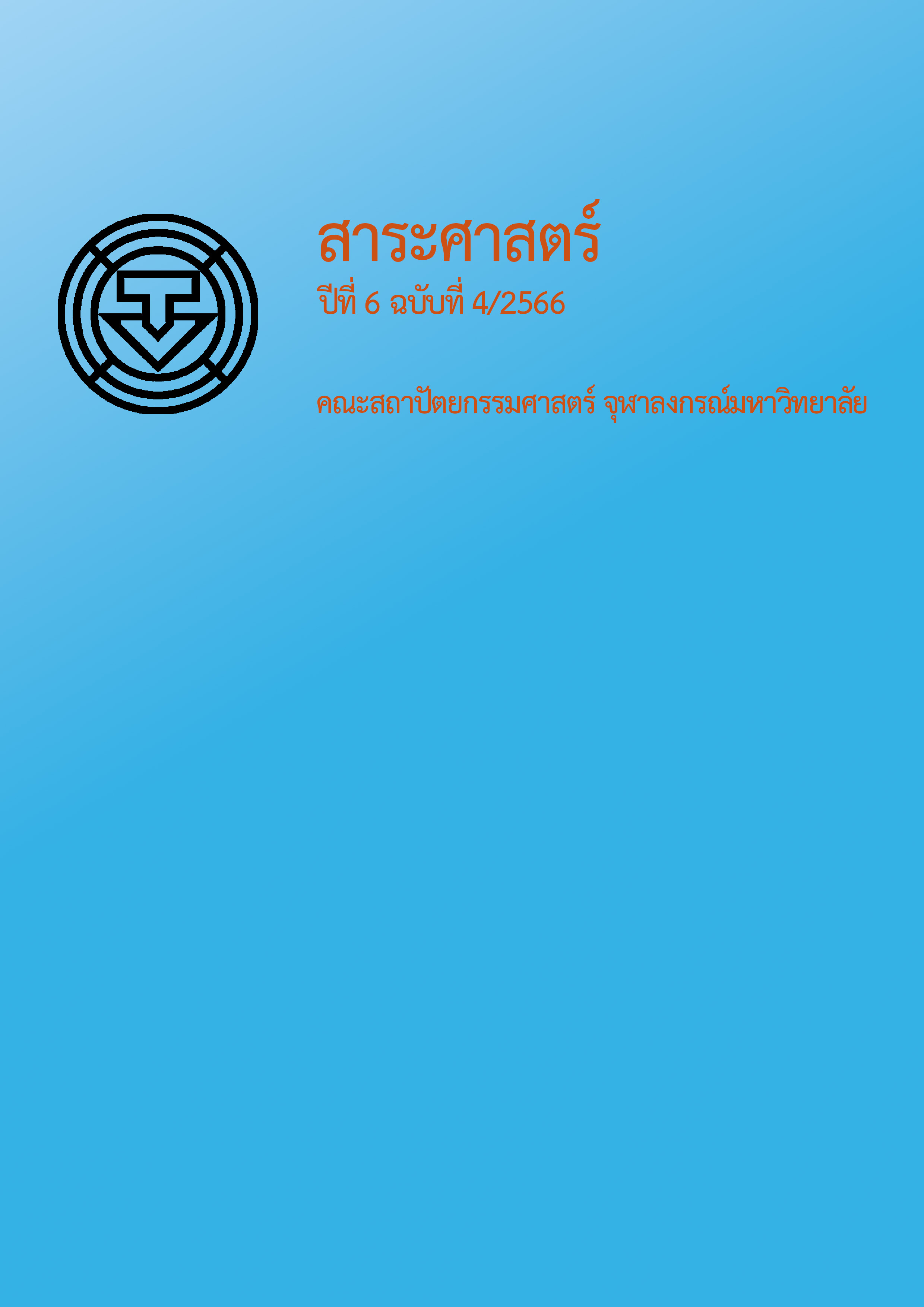Roles and Duties of Construction Management Consultant (CMC) in Implementing Building Information Modeling (BIM) in Government Sector Construction Projects
Main Article Content
Abstract
Since A.D. 2018, the public sector has been interested in implementing Building Information Model (BIM) in the construction process to reduce errors in fieldwork, affecting all related stakeholders, which are the owner, the designer, the contractor, and the construction management consultant (CMC), that must adjust their workflows due to the conversion. Meanwhile, the recent studies of the consultant’s scope of work involving BIM are still limited and lack of information from related parties. This led to the purpose of this study to find out the effects of using BIM on the CMC role, by interviewing 18 stakeholders from seven case studies.
Based on the research, government construction projects have four categories of BIM development process. Mostly, BIM has been created by the contractor to recreate new construction information during the construction process which opposes the theoretical framework of BIM process, leading to the discrepancy between the expected pre-construction timeline and the actual. From the 11 benefits of applying BIM in construction management, according to a review, the three most common uses are 1) 3D coordination during the construction process and As-built BIM, 2) Shop drawing and model, and 3) Planning and monitoring construction progress respectively. However, the major pain points are the lack of preparedness for CMC’s in BIM adoption, the unproficiency of personnel, the extra cost of software and license products, insufficient time caused by recreating the information, and the unclear scope of work.
The research shows the significant role of CMC in BIM adoption in the construction process, for building simulating construction process. Therefore, the CMC should be in every part of BIM adoption, which should consider the personnel and process problems in the first place.
Article Details
References
คณะกรรมการสาขาวิศวกรรมโยธา. (2559). ขอบเขตและหน้าที่การใหบริการวิชาชีพการบริหารงานก่อสร้าง (พิมพ์ครั้งที่ 4). วิศวกรรมสถานแห่งประเทศไทย ในพระบรมราชูปถัมภ์.
ทรงพล ยมนาค. (2560, 28 มกราคม). CM-BIM. Facebook. https://www.facebook.com/profile/100070878350658/search/?q=CM-BIM
ธนัชชา สุขขี. (2554). การศึกษาเลือกใช้แบบจำลองข้อมูลอาคารสำหรับอุตสาหกรรมก่อสร้างในประเทศไทย [วิทยานิพนธ์ปริญญามหาบัณฑิต ไม่ได้ตีพิมพ์]. มหาวิทยาลัยศิลปากร.
นพจิรา ฤกษ์ขจรนามกุล, วีระศักดิ์ ลิขิตเรืองศิลป์, และวิสุทธิ์ ช่อวิเชียร. (2563). การวิเคราะห์เอกสารสัญญาจ้างก่อสร้างสำหรับโครงการก่อสร้างซึ่งใช้การจำลองสารสนเทศอาคาร. ใน พัทรพงษ์ อาสนจินดา (บ.ก.), วิศวกรรมโยธากับโครงการเขตพัฒนาพิเศษภาคตะวันออกเพื่อการพัฒนาอย่างยั่งยืน. การประชุมวิชาการวิศวกรรมโยธาแห่งชาติ ครั้งที่ 25 (น. 422-431). Thaince. https://conference.thaince.org/index.php/ncce25/article/view/694
พิชชานันท์ สวัสดิ์เอื้อ. (2561). การศึกษาการเปลี่ยนแปลงขอบเขตหน้าที่ผู้ควบคุมงานตามสัญญาจ้างของโครงการอาคารหน่วยงานของรัฐ [วิทยานิพนธ์ปริญญามหาบัณฑิต ไม่ได้ตีพิมพ์]. จุฬาลงกรณ์มหาวิทยาลัย.
ระเบียบกระทรวงการคลัง ว่าด้วยการจัดซื้อจัดจ้างและบริหารพัสดุภาครัฐ พ.ศ. 2560. (2560, 23 สิงหาคม).ราชกิจจานุเบกษา. เล่ม 134 ตอน พิเศษ 210 ง หน้า 57-58.
วิศวกรรมสถานแห่งประเทศไทย ในพระบรมราชูปถัมภ์. (2560). แนวทางการทำงานแบบจำลองสารสนเทศอาคาร (BIM Guide). สมาคม.
สมาคมแบบจำลองสารสนเทศอาคาร. (2564). แนวทางการจัดทำวัตถุและวัสดุก่อสร้างสำหรับแบบจำลองสารสนเทศอาคาร (Thailand BIM object construction material guideline). สมาคม.
สมาคมวิศวกรที่ปรึกษาแห่งประเทศไทย. (2561, 23 สิงหาคม). มาตรฐานการปฏิบัติวิชาชีพการควบคุมงานก่อสร้าง [เอกสารนำเสนอ]. โครงการสนับสนุนการจัดทำมาตรฐานการปฏิบัติวิชาชีพใหม่และการปรับปรุงมาตรฐานการปฏิบัติวิชาชีพ, สภาวิศวกร กรุงเทพฯ.
สมาคมสถาปนิกสยาม ในพระบรมราชูปถัมภ์. (2558). แนวทางการใช้งานแบบจําลองสารสนเทศอาคารสำหรับประเทศไทย (Thailand BIM guideline).สมาคม.
สุดากาญจน์ ธนาวุฒิ. (2562). สถานการณ์ของการจัดทำแบบจำลองสารสนเทศอาคารก่อสร้างจริงในประเทศไทย ช่วงปีพ.ศ. 2553- 2562 [วิทยานิพนธ์ปริญญามหาบัณฑิต ไม่ได้ตีพิมพ์]. จุฬาลงกรณ์มหาวิทยาลัย.
Budak, A. & Karataş, I. (2022). Impact of the BIM system in construction management services in developing countries; Case of Turkey. Department of Civil Engineering, Osmaniye Korkut Ata University.
Computer Integrated Construction Research Program [CIC]. (2013). The uses of BIM classifying and selecting BIM uses. Pennsylvania State University. https://www.cic.psu.edu/
Computer Integrated Construction Research Program [CIC]. (2021). BIM project execution planning guide – Version 3.0. Pennsylvania State University. https://www.cic.psu.edu/
Eastman, C., Teicholz, P., Sack, R., & Liston, K. (2011). BIM handbook: A guide to building information, modeling for owners, designers, engineers, contractors, and facility managers (2nd ed.). John Wiley & Sons.
European Federation of Engineering Consultancy Associations [EFCA]. (2019). BIM and ISO 19650 from a project management perspective. https://www.efca.be/
Eynon, J. (2016). Construction manager’s BIM handbook. John Wiley & Sons.
Hardin, B. & Mccool, D. (2015). BIM and construction management proven tools, methods, and workflows (2nd ed.). John Wiley & Sons.
Hergunsel, M. F. (2011). Benefits of building information modeling for construction managers and BIM based scheduling [Unpublished graduate thesis]. Worcester Polytechnic Institute.
Xu, X., Ma, L., & Ding, L. (2014). A framework for BIM-enabled life-cycle information management of construction project. Hubei Key Laboratory of Control Structure, Huazhong University of Science & Technology.
Yalcinkaya. M. & Arditi, D. (2013). Building Information Modeling (BIM) and the construction management body of knowledge. Department of Structural Engineering and Building Technology, Aalto University.


